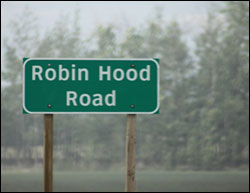“You shall never the poor man wrong…
You shall defend with all your power
Maids, widows, orphants (sic) and distressed men…”
– An oath Robin Hood is said to have required of his followers
 It might be impossible to overemphasize how ingrained in medieval English society the Robin Hood legend became during the high Middle Ages. Despite the confusion over his true identity, it could be argued that “Robin Hood” in all his many incarnations became the first ‘action hero’ of our culture. And because printed material was rare in the 12th and 13th century, the oral tradition of storytelling took up the exploits of everyone’s favorite outlaw and sent it across the English countryside like wildfire.
It might be impossible to overemphasize how ingrained in medieval English society the Robin Hood legend became during the high Middle Ages. Despite the confusion over his true identity, it could be argued that “Robin Hood” in all his many incarnations became the first ‘action hero’ of our culture. And because printed material was rare in the 12th and 13th century, the oral tradition of storytelling took up the exploits of everyone’s favorite outlaw and sent it across the English countryside like wildfire.
 Medieval maps are dotted with references to “Robin Hood’s Well” “Robin Hood’s Glen” “Robin’s Wood” and many other references to the brave outlaw. In later years, communities and villages celebrated “Robin Hood’s Day” with plays, feasts, wrestling matches and other festivities. In all the dramatic interpretations of the time, whether staged plays in London, or comical farces on the village green, Robin easily bests the Sheriff, Guy of Gisborne (the evil Bounty Hunter) and whatever other nefarious men attempt to best him.
Medieval maps are dotted with references to “Robin Hood’s Well” “Robin Hood’s Glen” “Robin’s Wood” and many other references to the brave outlaw. In later years, communities and villages celebrated “Robin Hood’s Day” with plays, feasts, wrestling matches and other festivities. In all the dramatic interpretations of the time, whether staged plays in London, or comical farces on the village green, Robin easily bests the Sheriff, Guy of Gisborne (the evil Bounty Hunter) and whatever other nefarious men attempt to best him.
By the 16th century, when English history was beginning to be recorded in books, Robin Hood became the follower of every English, Welsh or Scottish Hero from William Wallace to Simon de Montfort. While each of these patriots would no doubt choose to align himself with someone as popular with the people, as the great Robin Hood, it’s highly unlikely Hood could, assuming one man stood as the hero, could be in so many places at once.
Besides, by then, Robin Hood had become the most common alias in England. Whenever freemen sought to oppose tyranny in any form, they simply repeated the phrase:
“I am Robin Hood!”
*Thanks to Stephen Dafoe for the photo of Robin Hood Road





